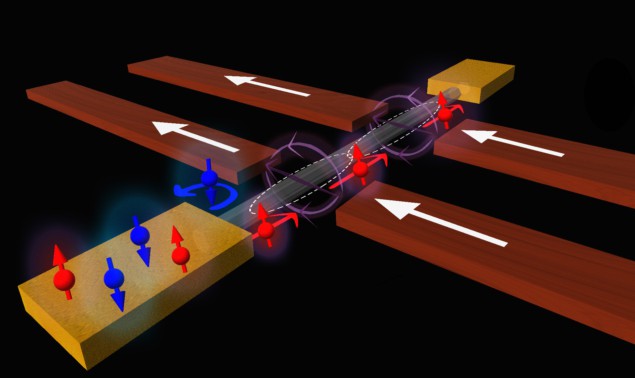
Researchers in Switzerland and Italy have developed a method for generating currents of electrons with a known quantum spin without the need for large external magnetic fields. This could enable the development of devices that are compatible with superconducting electronic elements, paving the way for the next generation of highly efficient electronics.
Following the discovery of giant magnetoresistance as well as the observation of spin injection and detection in metals in the late 1980s, a field of research known as “spintronics” emerged dedicated to creating practical devices that exploit electron spin. Semiconductor-based spintronics systems have garnered particular research interest because semiconductors can be integrated within modern-day electronics, thus improving the efficiency and storage capacity of devices. But in order to make useful spintronics devices, researchers need to be able to control and detect the spin state of electrons with a high level of accuracy.
Controlling electron spin
One method for controlling the electron spin current is a device known as the “spin valve”, which usually consists of a non-magnetic material sandwiched between ferromagnetic materials. This material configuration allows electrons with one spin to propagate through the device, while the opposite spin is reflected or scattered away. This occurs because spin propagation depends on the alignment of the magnetic moments in the ferromagnet. Thus, a “spin polarized current” is produced. This is a flow of electrons that, in theory, all are in a set spin state (all spin-up or all spin-down).

However, these types of spin valve are either not very efficient or require very large polarizing magnetic fields both imposing severe limitations on experiments — for example, experiments involving material systems that are sensitive to magnetic fields. To overcome this and achieve a highly spin-polarized current, researchers are looking for alternative methods to create spin valves using semiconductor materials.
Tiny magnetic fields
Now, physicists at the University of Basel along with collaborators at the National Enterprise for nanoScience and nanoTechnology have created a device that can control electron spin currents without the need for large external magnetic fields and with a high efficiency. In a recent paper published in Communications Physics, they describe how a pair of coupled quantum dots formed in an indium arsenide (InAs) nanowire with nearby individual nanomagnets can be used as a spin valve with an electrically tuneable spin polarization of up to ±80%.

Electric fields control spintronics devices
The team created the quantum dots by electrically defining two areas where electrons in the nanowire are confined in all three spatial directions. They then employed ferromagnetic side gates to generate small local magnetic fields across each dot. This gate-based configuration means that only very small magnetic field of up to 40 mT are needed to obtain a very high efficiency.
The device operates by generating a spin-polarized tunnel current using the first dot, which is then detected by the second dot. By magnetizing the ferromagnetic split gates in parallel or anti-parallel, the researchers can decide whether electrons of a certain spin can pass through each part of the device. The probability that an electron with that spin tunnels through both dots can be controlled using the ferromagnetic side gates, allowing a spin-polarized current to flow when they are aligned but no current at all if they are anti-parallel. The researchers were able to “tune” the device by experimenting with different applied fields and gate voltages. They were able to achieve a high spin polarization efficiency with the potential to reach the theoretical limit of 100%.
New quantum technologies
This type of spin valve could be very useful in applications for which magnetic fields can have a drastic impact on the material characteristics – such as suppressing superconductivity or altering electronic band structures. The manipulation of electron spin with such small magnetic fields may allow researchers to develop new quantum technologies that utilize spin-based quantum phenomena such as entanglement and the confirmation of Majorana fermions in topological superconductors along with facilitating the investigation into new unexplored physics.



